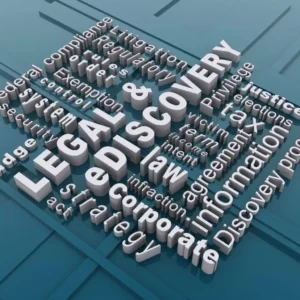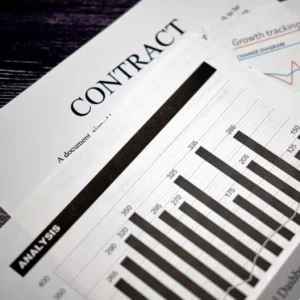
AI-driven Legal Analytics
Transforming Decision-making and Litigation Strategies
Historically characterized by its adherence to tradition, the legal sector is undergoing a paradigm shift courtesy of AI-driven legal analytics. Get ready to witness the industry breaking free from its conventional boundaries!
Thanks to the infusion of machine learning, predictive analytics, and natural language processing, we are about to embark on an exciting journey of unparalleled innovation and transformation.
This article delves into the multifaceted implications of such technologies. Get ready to witness an exciting change in the legal world! With the help of AI-powered legal data visualization tools, we can now easily streamline and analyze complex legal documents.
And that’s not all – predictive analytics is now being used to gain an edge in litigation strategy, giving you unprecedented advantages in the courtroom. Exciting times are ahead for the legal arena!
As you journey through, you’ll explore the potent combination of technology and law and how it’s redefining client engagements, litigation strategies, and the broader vision of legal enterprises.
Table of Contents
Visualizing Data for Better Legal Decision-making
In today’s digital age, vast amounts of data are generated daily. However, harnessing this data is the real challenge. Enter AI-driven legal analytics. This powerful tool is reshaping how legal professionals interact with data. Instead of sifting through endless sheets and numbers, attorneys can now rely on AI-driven legal data visualization. This technology converts intricate datasets into intuitive visual representations, making patterns and anomalies easier to spot.
Moreover, as legal data becomes complex, natural language processing for legal data interpretation occurs. It aids in deciphering legalese and ensures that data is visual and understandable. Combined with machine learning for case pattern recognition, law practitioners can swiftly recognize recurring themes or trends in cases.
But it’s not just about recognizing patterns. Predictive analytics in litigation strategy offers a strategic advantage by forecasting outcomes based on historical data. Imagine crafting winning litigation plans by predicting court decisions or opponent moves!
As legal firms venture deeper into the digital realm, the role of AI for legal KPI tracking becomes invaluable. It ensures firms stay on track, meet their goals, and keep up with evolving legal trends.
With all these advancements, one might wonder: How is the landscape of legal business insights transforming with the integration of AI?
Crafting Winning Litigation Strategies with AI
The legal landscape is undergoing a massive transformation thanks to AI-driven legal analytics. Inherently unpredictable and complex litigation can significantly benefit from this technological revolution. Utilizing predictive analytics in litigation strategy, attorneys can now anticipate the likely outcomes of cases based on past verdicts and evolving legal trends.
A blend of machine learning for case pattern recognition and natural language processing for legal data interpretation makes it possible to dissect past cases. This analytical approach helps identify common threads, past rulings, or opposing counsel’s tendencies. Combined with these tools, it’s like equipping legal teams with a strategic crystal ball!
AI in legal trend analysis further elevates this approach. Lawyers are not just predicting; they strategize based on actionable insights from vast legal databases. Whether understanding the nuances of a judge’s previous rulings or knowing when to push for a settlement, AI tools provide a roadmap.
But how does this AI-powered approach integrate with the broader business strategy of law firms? And what does this mean for AI-enhanced legal business insights and ensuring the growth and success of law practice?
Keeping Tabs on Key Performance Indicators
In any industry, monitoring key performance indicators (KPIs) is crucial for success, and the legal sector is no exception. AI-driven legal analytics offers a game-changing approach to KPI tracking. Gone are the days of manually sifting through data or relying solely on intuition. With AI for legal KPI tracking, law firms can seamlessly keep a pulse on their performance metrics.
By leveraging machine learning for case pattern recognition, these AI systems can identify patterns in a firm’s success rate, client satisfaction levels, or even the efficiency of specific processes. This deep dive into data doesn’t just highlight numbers but pinpoints areas of improvement.
Furthermore, integrating natural language processing for legal data interpretation ensures that complex legal documents, contracts, and correspondences are analyzed accurately. This means law firms can gauge the success of specific clauses or strategies based on real-time data.
With AI-driven client behaviour analytics, understanding the client becomes more precise. Firms can anticipate client needs and preferences, leading to improved client relationships and retention rates.
With all these advanced tracking tools at their fingertips, how are law firms adapting their strategies? And what potential does AI hold for transforming the broader legal landscape?
Spotting Emerging Legal Trends
Navigating the ever-evolving landscape of the legal industry requires an acute awareness of emerging trends. AI-driven legal analytics has emerged as a formidable tool, allowing professionals to stay ahead of the curve. By leveraging AI in legal trend analysis, firms can identify patterns and shifts in the legal sphere before they become mainstream.
One of the most impactful tools in this endeavour is machine learning for case pattern recognition. This facet of AI meticulously scans previous case outcomes, legislative changes, and even public sentiment to identify nascent trends. It’s not just about looking at the past but predicting the future.
Coupled with natural language processing for legal data interpretation, law firms can delve deeper into vast data. This dual approach ensures that every stone is turned on, from analyzing intricate legal documents to understanding shifts in legal jargon.
This proactive approach gives a competitive edge and influences predictive analytics in litigation strategy. By understanding what’s on the horizon, attorneys can craft strategies aligned with future legal trajectories.
With AI streamlining the process of trend spotting, how will law firms recalibrate their services? And what could be the next big trend detected by AI’s sharp analytical eye?
Recognizing Recurring Case Patterns
Patterns are everywhere in the legal world. Yet, identifying them manually, especially in a sea of cases, is a gargantuan task. AI-driven legal analytics becomes a beacon, illuminating these patterns like never before. By harnessing the power of machine learning for case pattern recognition, attorneys can quickly spot recurring themes, arguments, or strategies that have proven effective in similar cases.
This pattern recognition goes hand-in-hand with natural language processing for legal data interpretation. It enables the extraction of critical insights from vast repositories of legal texts, from court decisions to scholarly articles. Thus, even the subtlest patterns obscured in legalese become instantly accessible.
Additionally, with the integration of predictive analytics in litigation strategy, these recognized patterns form the foundation for forecasting potential case outcomes. It’s like having a seasoned legal mentor who has seen every case imaginable, offering advice.
AI-driven client behaviour analytics further complements this. By understanding past client behaviours and outcomes, firms can tailor their approach to suit each unique case, ensuring the best possible results.
But as AI continues to recognize these patterns, how will it shape the strategies of future litigators? And how might this technology redefine success in the courtroom?
Deciphering Complex Legal Data Sets
The world of law is entrenched in rich, multifaceted data. Every case, contract, and legal document contributes to vast data sets, often too intricate for manual analysis. This is where AI-driven legal analytics swoops in, offering a transformative solution.
A cornerstone of this transformation is natural language processing for legal data interpretation. Complex legal jargon, clauses, and provisions, which once took hours to decipher, are now understood in mere moments. This ensures that insights gleaned are not just accurate but also actionable.
In tandem with this, machine learning for case pattern recognition delves deeper, identifying correlations within these data sets. It unveils patterns spanning decades or even centuries, guiding legal professionals in their decision-making processes.
This profound understanding of data also fuels predictive analytics in litigation strategy. The AI can forecast future legal trajectories by comprehending past and present data sets, making strategic planning more precise.
But the magic doesn’t stop there. The fusion of AI-driven legal data visualization transforms these insights into interactive, intuitive visuals, making complex data more digestible.
So, as AI continues to simplify these intricate data sets, how will the role of legal professionals evolve? And what new horizons might this open up for the next generation of lawyers?
Driving Business Decisions with Legal Insights
In today’s business world, every move counts. That’s why having access to valuable legal insights is crucial. With AI-powered legal analytics, firms can transform raw data into actionable strategies. It’s like having a secret weapon that equips you with the insights you need to navigate the complex business landscape and stay ahead of the competition. Say goodbye to guesswork and hello to informed decision-making!
One of the core strengths of AI in this domain is predictive analytics in litigation strategy. This helps law firms anticipate potential legal challenges and prepares them to adapt to evolving market conditions. Being forearmed with such insights ensures businesses can remain resilient even in tumultuous times.
Firms can spot industry-specific legal patterns by harnessing machine learning for case pattern recognition. When interpreted correctly, these patterns can give firms a competitive edge, dictating everything from contract negotiations to business expansions.
The role of AI-enhanced legal business insights cannot be understated. They provide a 360-degree view of the legal business nexus, assisting stakeholders in making legally sound and commercially viable decisions.
With AI-driven client behaviour analytics, firms are better positioned to anticipate and cater to the evolving needs of their clientele, ensuring longevity and fostering trust.
How might the business world adapt to this new paradigm with AI transforming business decisions? And what opportunities could these AI-infused legal insights unlock for businesses worldwide?
Understanding Client Needs and Behaviours
Understanding client needs and behaviours lies at the heart of every successful legal venture. AI-driven legal analytics is reshaping how law firms perceive and cater to their clientele, ensuring that client relationships are stronger and more informed than ever.
Law firms can glean insights into how clients interact with their services with AI-driven client behaviour analytics. This data-driven approach reveals preferences, pain points, and anticipatory needs, enabling firms to tailor their offerings precisely.
Furthermore, by integrating machine learning for case pattern recognition, firms can identify patterns in how specific client demographics approach litigation or contractual negotiations. This foresight allows for proactive strategy formulation, aligning perfectly with the client’s goals and expectations.
The role of natural language processing for legal data interpretation is also pivotal. Firms can decode their clients’ underlying sentiments and preferences by analyzing past correspondences, feedback, and queries.
Meanwhile, predictive analytics in litigation strategy ensures client needs are met and anticipated. This forward-thinking approach sets the foundation for lasting client relationships.
As AI continues to fine-tune our understanding of client behaviours, how will this redefine the attorney-client relationship? And what new avenues of personalized legal service might this technological renaissance open up?
Predicting and Ensuring Law Firm Growth
In the competitive world of law, growth is paramount. Yet, predicting and ensuring such growth often feels like looking into a murky crystal ball. Enter AI-driven legal analytics, the technological torchbearer illuminating pathways to sustainable development for law firms.
Utilizing predictive analytics in litigation strategy allows firms to gauge potential future scenarios, from emerging market trends to client behaviour shifts. By forecasting these dynamics, law firms can allocate resources more effectively, ensuring they’re always ahead of the competition.
The magic of machine learning for case pattern recognition further aids in understanding the evolving landscape. By recognizing recurring case patterns and client preferences, firms can tailor their services, ensuring they’re always in demand.
Moreover, AI-driven client behaviour analytics offer a deep dive into client interactions and satisfaction levels. When acted upon, these insights can lead to enhanced client retention and acquisition, which is pivotal for growth.
Furthermore, AI’s role in law firm growth analysis must be considered. By evaluating past performances and comparing them with industry benchmarks, firms can identify areas of improvement and opportunity.
But as AI continues to revolutionize growth strategies, how might the dynamics of competition change among law firms? And what new challenges and opportunities will these advanced growth strategies usher in?
The Dawn of the AI-driven Legal Enterprise
Traditionally steeped in precedent and procedure, the legal industry stands on the precipice of a new era. The emergence of AI-driven legal analytics is not just an upgrade—it’s a transformative force reshaping the very fabric of legal enterprises.
This transformation touches every facet of the profession. With AI-driven legal data visualization, dense pages of legal precedents become interactive visual maps, simplifying complex datasets into comprehensible insights. This enables attorneys to make quicker and more informed decisions.
When we dive into litigation, predictive analytics in litigation strategy equips lawyers with a strategic advantage, allowing them to anticipate courtroom scenarios and counterarguments before they manifest. The capability to foresee can often mean the difference between a win and a loss.
Machine learning for case pattern recognition further streamlines case management. By identifying patterns, firms can predict case outcomes with a level of accuracy previously thought impossible.
Furthermore, natural language processing for legal data interpretation sifts through vast legal documents, extracting vital information in seconds—a task that once took hours.
Yet, as the legal world becomes increasingly AI-centric, one must ponder: How will this tech-driven evolution impact the human element of the legal profession? And as we step further into this AI-augmented reality, what ethical considerations will we be compelled to navigate?
Concluding Thoughts: The AI-driven Legal Frontier
Adopting AI-driven legal analytics heralds a new epoch for the legal industry, answering pressing questions while raising intriguing new ones. Legal enterprises now stand empowered, transforming dense legal data into insightful AI-driven legal data visualization. This shift doesn’t merely streamline operations; it revolutionizes decision-making, ensuring that attorneys are better equipped.
Delving into litigation, the capabilities of predictive analytics in litigation strategy have showcased their potential, offering foresight that lends a significant strategic advantage. Such forward-thinking, coupled with the precision of machine learning for case pattern recognition, ensures law firms are always steps ahead, anticipating outcomes and crafting strategies accordingly.
The transformative power of natural language processing for legal data interpretation can’t be understated. It elevates efficiency, turning hours of document review into mere moments. This efficiency, combined with AI-driven client behaviour analytics insights, guarantees a tailored approach to client needs and paves the way for sustained law firm growth.
Yet, amidst this technological renaissance, it’s imperative to remember the human element. AI magnifies human potential, but it also raises ethical dilemmas. As the dawn of the AI-driven legal enterprise emerges, a balanced approach—embracing technological marvels while staying grounded in human ethos—will be the lynchpin to success.
So, as we stand at this intersection of tradition and technology, the question remains: How will we, as an industry, ensure that the essence of justice and ethical practice thrive alongside this AI-driven evolution?
Related Articles
- AI in Pro Bono Case Selection: Maximizing Impact
- AI in Alternative Dispute Resolutions: The New Mediator
- AI in Courtroom Support: Revolutionizing Evidence Compilation
- AI-Driven IP Management: From Patents to Trademarks
- AI-Driven Document Categorization: Legal Filing Transformed
- AI in Compliance Monitoring: Legal Standards and Predictive Oversight
- AI-Driven Legal Chatbots: Future of Attorney-Client Interactions
- AI-Driven E-Discovery Platforms: Enhanced Efficiency and Precision
- AI-driven Legal Analytics: Transforming Decision-making and Litigation Strategies
- AI-Driven Legal Research: How Technology is Reshaping the Future of Law
- AI for Contract Analysis: Streamlining Processes and Predicting Success
- Other Articles on AI Usage in Legal
- Other Articles on AI usage in different industries
























